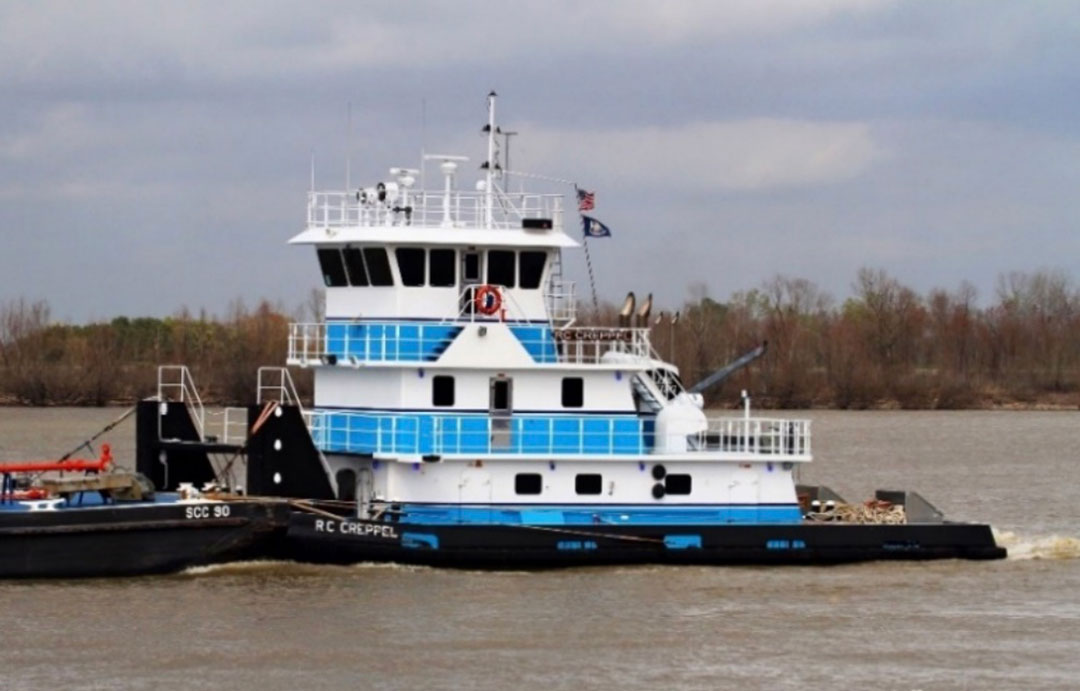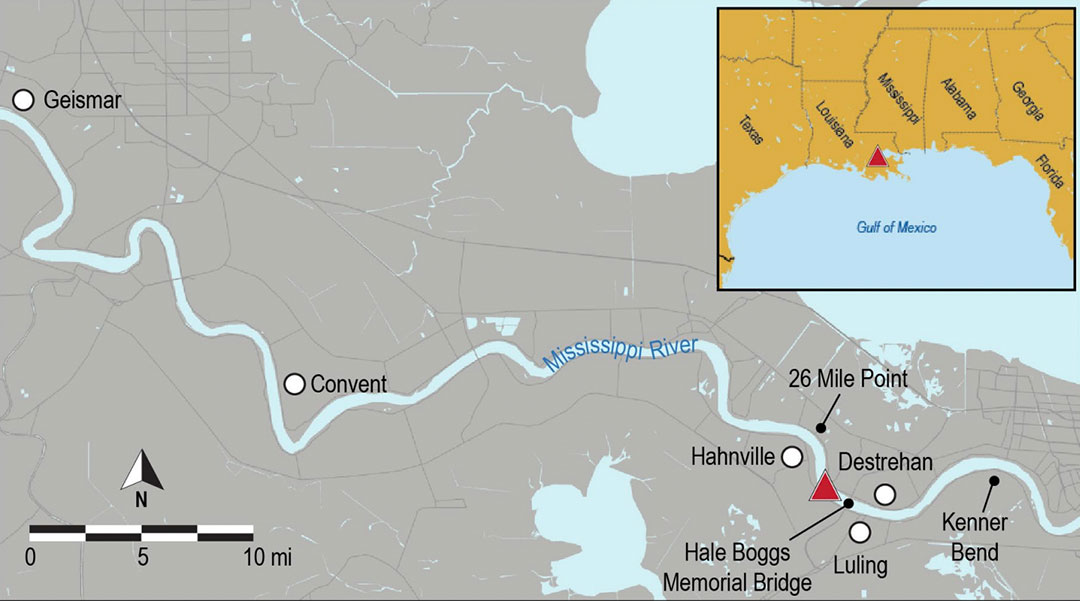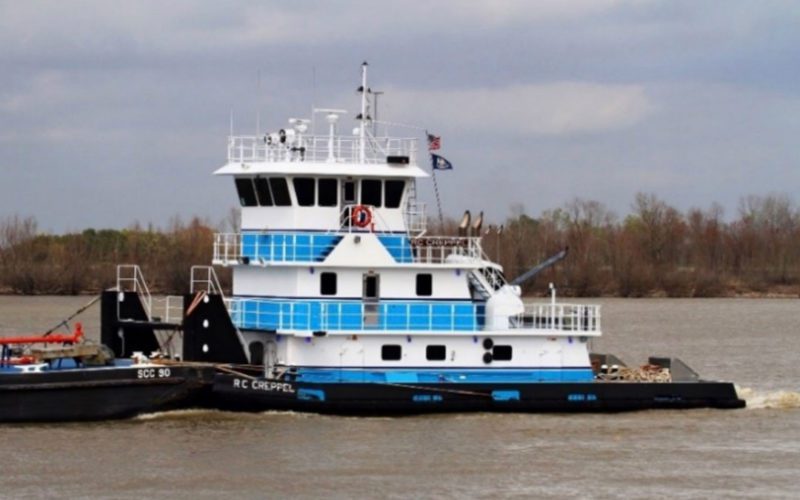
Both towboats involved in a fatal collision in the Lower Mississippi River near Destrehan, La., in early 2020 broadcast inaccurate tow lengths over AIS, according to federal investigators.
The National Transportation Safety Board (NTSB), which investigated the collision involving Cooperative Spirit and R.C. Creppel, also cited inadequate communication between pilots helming the two tows in the minutes leading to the collision.
“Since the Cooperative Spirit pilot did not inform the R.C. Creppel pilot of the size or length of his respective tow when they planned their meeting, nor did the R.C. Creppel pilot inquire as to its size, the R.C. Creppel was likely unaware of the length of the Cooperative Spirit tow,” the NTSB said in its accident report. “The two pilots had arranged the meeting without a complete understanding of the developing situation.”

Barges pushed by Cooperative Spirit and R.C. Creppel collided at 0533 on Jan. 26, 2020, at Lower Mississippi Mile 123, near 26 Mile Point and the Hale Boggs Memorial Bridge. Three of four crewmembers aboard R.C. Creppel died when the vessel capsized. The upbound bulker Glory First also struck Cooperative Spirit’s barges after the initial collision.
All 40 of Cooperative Spirit’s barges broke free, as did both of R.C. Creppel’s barges. Sulfuric acid vapors from one of R.C. Creppel’s barges entered the atmosphere, and up to 8,000 gallons of diesel escaped into the waterway after the towboat capsized. Vessel damage from the incident approached $3.8 million.
The 1,680-hp R.C. Creppel was downbound in the Mississippi with two barges in tow on the morning of the collision. Its total length was 514 feet, although it broadcast just 69 feet over AIS. The 10,500-hp Cooperative Spirit was upbound with 40 barges, and its total length was 1,600 feet, but it showed 200 feet on AIS.
Ten minutes before the incident, the pilot of the upbound Cooperative Spirit radioed his counterpart on R.C. Creppel to arrange a meeting. They were about 3.5 miles apart, and both agreed to meet port-to-port near 26 Mile Point. Neither pilot could see the other around the bend.
On the radio call, R.C. Creppel’s pilot described the size of his tow, but Cooperative Spirit’s pilot did not and R.C. Creppel’s pilot didn’t ask how long it was, the report said. Neither pilot made subsequent radio contact.
Cooperative Spirit’s pilot steered a course near the left descending bank. The tow traveled at about 4.6 mph, and the current nudged it toward the center of the channel.
R.C. Creppel made about 13 mph, pushed by a 6-mph current. The nearest river gauge, 20 miles downriver at Carrollton in New Orleans, showed the river was high but not at flood stage.
When the lead barges on both tows were about a half-mile apart, Cooperative Spirit continued a slow turn to port, away from the bank. Video from Cooperative Spirit shows R.C. Creppel’s navigation and deck lights clearing the background lighting at about 0532 with the tows about a quarter-mile apart.
“Once in sight of one another, about 50 seconds before the accident, there was minimal time for either pilot to react or respond to the other vessel’s movements to avoid collision,” the NTSB determined.
The collision happened at 0533 when the front of Cooperative Spirit’s tow collided with R.C. Creppel’s empty lead barge, SCC-95. That barge broke free, and Cooperative Spirit’s barge ART 44311 hit R.C. Creppel’s other barge, RHA-2204, allowing the sulfuric acid vapors to release from a damaged valve.
R.C. Creppel’s lone surviving crewmember, a deck hand, saw water enter through the galley’s open main deck starboard door. He swam up the galley toward the port-side door, pushed it open and entered the water. The vessel capsized and sank in a matter of seconds.
Had that starboard watertight door been properly closed, the NTSB suggested, all four crewmembers might have had time to escape the vessel.
The deck hand swam to a nearby barge and hung onto a hanging wire. He was rescued about 50 minutes later, more than a mile downriver. The three other crewmembers aboard R.C. Creppel have not been found and are presumed dead, including its pilot.
The upbound bulker Glory First, under the guidance of a New Orleans-Baton Rouge Steamship Pilot Association (NOBRA) pilot, struck several barges still attached to Cooperative Spirit at about 0540, causing more barges to break free.
The NOBRA pilot slowed the ship and tried to steer around the collision. The two tows were blocking much of the river, and the ship was unable to avoid the impact, the report said.
The NTSB investigation emphasized the importance of towing vessels entering accurate lengths for their entire tow into AIS — even though it is not required by federal regulation.
The fatal incident near the Hale Boggs bridge was not the first incident of this kind. In 2014, the agency identified a similar probable cause in a Houston Ship Channel collision between the bulk carrier Summer Wind and Miss Susan’s tow that spilled 168,000 gallons of fuel.
In 2016, the NTSB published a safety study that assessed the Coast Guard’s Vessel Traffic System, finding that “the Coast Guard may be limited in its ability to detect potential collisions, allisions and groundings” without accurate information about vessel and tow configuration.
Based on that assessment, the agency issued a series of safety recommendations asking that the Coast Guard, the American Waterways Operators and the Radio Technical Commission work on modifying regulations, procedures and standards so that “vessels engaged in towing operations broadcast accurate automatic identification system information.”
In May 2020, four months after R.C. Creppel and Cooperative Spirit collided, the Coast Guard published a safety alert recommending vessel operators “ensure that accurate and up-to-date information is entered into the AIS.”
“The accurate display of a vessel’s full length becomes particularly important in situations that prevent vessels from seeing each other until they are in very close proximity,” the alert said.
R.C. Creppel could not be salvaged nor examined due to the strong currents and poor visibility underwater. The towboat’s owner, Elite Towing, declined to comment on the NTSB findings.
American River Transportation Company, the owner and operator of Cooperative Spirit, did not respond to an inquiry.

